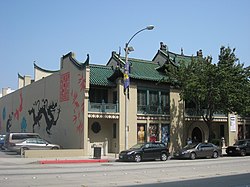
Pasadena is a city in Los Angeles County, California, United States, 11 miles (18 km) northeast of Downtown Los Angeles. It is the most populous city and the primary cultural center of the San Gabriel Valley. With its substantial downtown area, observers consider it as either a suburb of nearby Los Angeles, or as a significant urban center in its own right.

The Norton Simon Museum is an art museum located in Pasadena, California, United States. It was previously known as the Pasadena Art Institute and the Pasadena Art Museum and displays numerous sculptures on its grounds.

The Isabella Stewart Gardner Museum is an art museum in Boston, Massachusetts, which houses significant examples of European, Asian, and American art. Its collection includes paintings, sculpture, tapestries, and decorative arts. It is originally the home of Isabella Stewart Gardner, whose will called for her art collection be permanently exhibited "for the education and enjoyment of the public forever".
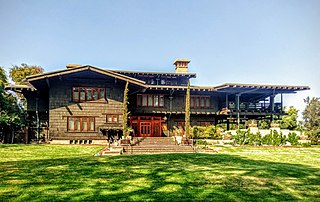
The Gamble House, also known as the David B. Gamble House, is an iconic American Craftsman home in Pasadena, California, designed by the architectural firm Greene and Greene. Constructed in 1908–09 as a home for David B. Gamble of the Procter & Gamble company, it is today a National Historic Landmark, a California Historical Landmark, and open to the public for tours and events.
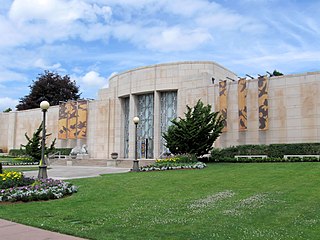
The Seattle Asian Art Museum is a museum of Asian art at Volunteer Park in the Capitol Hill neighborhood of Seattle, Washington, United States. Part of the Seattle Art Museum, the SAAM exhibits historic and contemporary artworks from China, Korea, Japan, India, the Himalayas, and other Southeast Asian countries. It also features an education center, conservation center, and library. The museum is located in the 1933 Art Deco building which was originally home to the Seattle Art Museum's main collection. In 1991 the main collection moved to a newly constructed Seattle Art Museum building in the downtown area. The Seattle Asian Art Museum opened in 1994.
The culture of Los Angeles is rich with arts and ethnically diverse. The greater Los Angeles metro area has several notable art museums including the Los Angeles County Museum of Art (LACMA), the J. Paul Getty Museum on the Santa Monica mountains overlooking the Pacific, the Museum of Contemporary Art (MOCA), and the Hammer Museum. In the 1920s and 1930s Will Durant and Ariel Durant, Arnold Schoenberg and other intellectuals were the representatives of culture, in addition to the movie writers and directors. As the city flourished financially in the middle of the 20th century, culture followed. Boosters such as Dorothy Buffum Chandler and other philanthropists raised funds for the establishment of art museums, music centers and theaters. Today, the Southland cultural scene is as complex, sophisticated and varied as any in the world.
The Pasadena Society of Artists is a nonprofit arts organization in southern California, United States. It holds annual art exhibitions of its members' art works.

Architectural Resources Group is a firm that was founded in 1980 by Bruce Judd and Steve Farneth in San Francisco, CA. It began by providing professional services in the fields of architecture and urban planning with particular expertise in the area of historic preservation. In 2000, David Wessel, a Principal of ARG, founded a separate conservation-contracting division, ARG Conservation Services which operates under the same roof as ARG. By 2005, the firm had expanded to a full-service architecture firm with 50+ employees. ARG also opened offices in Pasadena serving Southern California, and Portland, Oregon, serving the Pacific Northwest.
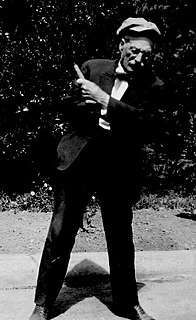
Frederick Louis Roehrig was an early 20th-century American architect. Roehrig was born in LeRoy, New York, the son of the noted "orientalist and philoligist," Frederick L.O. Roehrig He graduated from Cornell University in 1883 and also studied architecture in England and France. His architectural styles evolved over time, covering the Victorian, American Craftsman, and Neo-Classical styles. Roehrig is particularly known for his many landmark buildings in Pasadena, California, including the Hotel Green, and Pasadena Heritage has occasionally conducted tours of Roehrig's buildings.

Playhouse Village, a neighborhood in Pasadena, California, is a dynamic 32-block downtown setting featuring a unique blend of captivating retailers, innovative restaurants, urban living, and unmatched cultural destinations. Playhouse Village is bordered by Interstate 210 to the north, California Boulevard to the south, Los Robles Avenue to the west, and Hudson Avenue to the east, with a panhandle-like extension to Wilson Avenue. The district is also notable for its manhattanization, the legacy of extensive urbanization from the 1960s to the 1980s.
The USC School of Architecture (USCArchitecture) is the architecture school at the University of Southern California. Located in Los Angeles, California, it is one of university's 17 professional schools, offering both undergraduate and graduate degrees in the fields of architecture, building science, landscape architecture and heritage conservation.
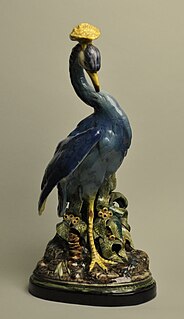
California pottery includes industrial, commercial, and decorative pottery produced in the Northern California and Southern California regions of the U.S. state of California. Production includes brick, sewer pipe, architectural terra cotta, tile, garden ware, tableware, kitchenware, art ware, figurines, giftware, and ceramics for industrial use. Ceramics include terra cotta, earthenware, porcelain, and stoneware products.

Marston, Van Pelt, & Maybury and associated partnership names were architects in Pasadena, California.
Roland Coate was an American architect. He designed many houses and buildings in California, three of which are listed on the National Register of Historic Places.

A bungalow court is a style of multi-family housing which features several small houses arranged around a central garden. The bungalow court was created in Pasadena, California in 1909 and was the predominant form of multi-family housing in Southern California from the 1910s through the 1930s. Homes in bungalow courts were generally small, low-rise houses in the spirit of bungalow design; however, the homes were designed in a variety of architectural styles, including Swiss chalet and Spanish Colonial Revival. Bungalow courts also integrated their courtyards with the homes, providing green space to homeowners.
Pacific Standard Time: Art in L.A., 1945–1980 was a scholarly initiative funded by the J. Paul Getty Trust to historicize the contributions to contemporary art history of artists, curators, critics, and others based in Los Angeles. Planned for nearly a decade, PST, as it was called, granted nearly 60 organizations throughout Southern California a total of $10 million to produce exhibitions that explored the years between 1945 and 1980. Underscoring the significance of this project, art critic Roberta Smith wrote in The New York Times:
Before [PST], we knew a lot [about the history of contemporary art], and that lot tended to greatly favor New York. A few Los Angeles artists were highly visible and unanimously revered, namely Ed Ruscha and other denizens of the Ferus Gallery, that supercool locus of the Los Angeles art scene in the 1960s, plus Bruce Nauman and Chris Burden, but that was about it. After, we know a whole lot more, and the balance is much more even. One of the many messages delivered by this profusion of what will eventually be nearly 70 museum exhibitions is that New York did not act alone in the postwar era. And neither did those fabulous Ferus boys.

Grace Nicholson was an American art collector and art dealer, specializing in Native American and Chinese handicrafts. The space she originally designed for her shop is now home to the USC Pacific Asia Museum in Pasadena, California.
Gilbert L. Leong (1911-1996) was a Chinese-American architect who designed churches and public buildings in the Los Angeles area. He was the first Chinese-American to graduate from USC with a degree in architecture. His designs helped shape the architecture of postwar Los Angeles and Chinatown. Leong was also a co-founder of the East West Bank in 1973. The bank was set up to serve the Chinese American community in Southern California.
Smith and Williams was an architecture firm based in South Pasadena, California and created in 1949. They were noted for their Modernist and Googie design style. The firm developed buildings and master planned communities. The Smith-Williams partnership was active until 1973.
